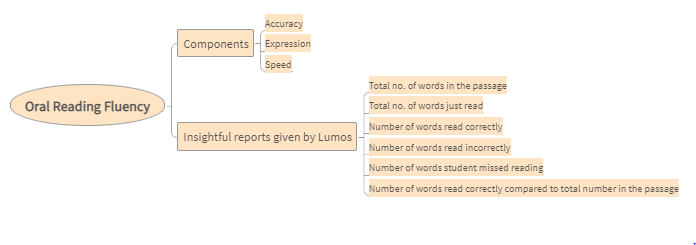
According to The United States’ National Reading Panel’s fluency can be defined as the ability to read text with accuracy, appropriate rate, and good expression (NICHD, 2000).
Oral reading fluency is one of several critical factors necessary for reading comprehension mastery. While some students may find it easy to read words, they may have difficulty deriving meaning, stringing words together to create sentences, and, ultimately, creating a narrative. Oral reading fluency plays a crucial role in developing students’ ability to read a text accurately, quickly, and with expression.
What are the components of Oral Reading Fluency?
- Accuracy: Ability to speak correctly with few mistakes.
- Expression: The most common elements include voice pitch, sound length, the variation between soft and loud sounds, stress on certain words and syllables, and the timbre, or quality, of the sound.
- Speed: Ability to read at an appropriate rate of speed for their age or grade level (usually measured in Words Per Minute or WPM).
Why is Oral Reading Fluency Important?
Reading fluency is an essential measure of overall reading ability. Sobering evidence from multiple sources indicate that failing to learn to read before the third or fourth year of schooling may mean life-long problems in skills central to literacy. Less fluent readers focus their attention on figuring out the words, leaving them little attention to understanding the text’s meaning.
Fluent reading leads to more success with writing, better vocabulary skills, and a greater understanding of what is being read.
How to Improve Reading Fluency for Students?
Students can improve their reading fluency with explicit, systematic instruction. Treatment should be individually designed to address specific underlying weaknesses. Parents and Teachers can help by modeling fluent reading and engaging in tandem oral reading activities (such as “echo” reading and choral reading). Repeated oral reading of a passage also builds overall reading fluency by giving repeated practice in phrasing, scanning, prosody, and word recognition.
At Lumos, we have a vast collection of grade-specific free reading passages and an innovative reading fluency analyzer, which can quickly check the reader’s reading accuracy, speed, and expression.
It provides the option to record what the student is reading. They can also use the ‘Read-Along’ feature, which utilizes computer-aided voice support to help them read effortlessly. Once the recording is complete, it automatically analyzes the audio to provide insightful reports:
- The total number of words in the passage.
- The total number of words just read.
- The number of words read correctly.
- The number of words read incorrectly.
- Number of words the student missed reading.
- Most importantly, the accuracy, i.e., the number of words read correctly compared to the total number of words in the passage.
The transcribed text shows the correct, incorrect, and missing words. These are highlighted with different color codes to better understand the reading gaps.
What’s more, it shows up some interesting graphs – the Pitch Graph and the Intensity graph.
The Pitch Graph will show the pitch variations in oral reading text. Hovering the mouse over the graph area shall accurately show the pitch variation for specific words read by the student, measured in Hertz.
Whereas the Intensity Graph will show how the student has emphasized each word while reading. Hovering the mouse over the graph area shall accurately show the intensity variation for specific words read by the student, measured in Decibel.
The Lumos Reading Fluency Analyzer is designed to help students of all grades do sustained on-going practice and improve reading fluency over time.
Check out the video demonstration below by Darcy to learn how Lumos Reading Fluency Analyzer works and help your students become fluent readers.






